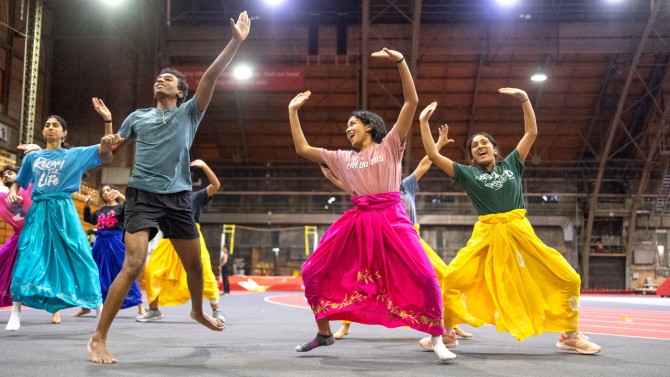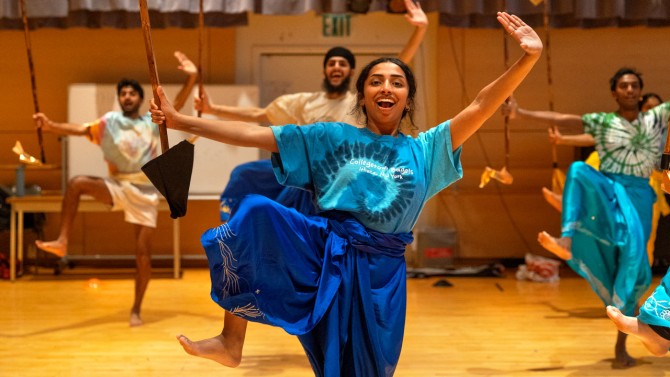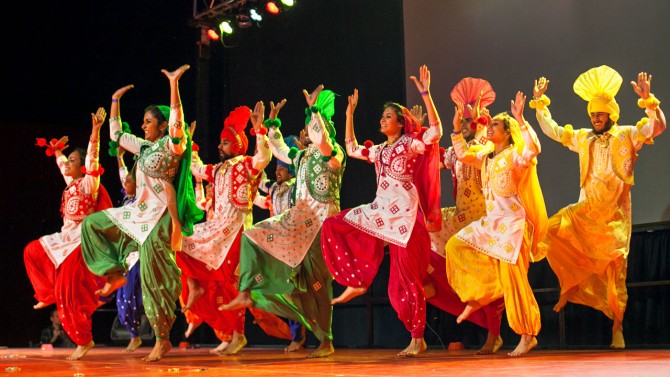Cornell Bhangra to unite community with ‘intoxicating joy’
By Caitlin Hayes, Cornell Chronicle
When Amulya Puttaraju ’24 came to Cornell in 2020, she needed to restore her sense of hope.
Her senior year of high school had moved mostly online due to COVID, and a debut classical dance performance she had worked towards for years was cancelled.
She rediscovered her drive, and her joy, in Cornell Bhangra, a long-standing campus group that practices a modern take on a traditional Punjabi folk dance.
“The whole basis of Bhangra is to bring community together, to celebrate things like the harvest and to have fun, together. Bhangra literally means ‘intoxicated with joy,’” said Puttaraju, a student in the Cornell Nolan School of Hotel Administration, part of the Cornell SC Johnson College of Business, who serves as one of two team captains.
“It’s pushed me so much in terms of my personal growth,” Puttaraju said. “Having Bhangra and being able to apply myself in a different context has shown me that I’m capable of so much.”
Cornell Bhangra, founded in 1997, is one of the oldest and best collegiate Bhangra teams in the country, routinely competing and placing at nationals and performing at numerous local events and regional competitions throughout the year. In 2014, the team appeared on NBC’s “Today Show” and “America’s Got Talent,” and in November 2023, they were the first Bhangra team ever featured at the Macy’s Day Thanksgiving Parade.
The current team of 32 students will host its annual exhibition for the Cornell and Ithaca community, the 21st PAO Bhangra, on March 16 at 6:30 p.m. in Barton Hall. Historically, the event has drawn some of the largest audiences for Bhangra showcases in the country – it peaked at 2,600 people in 2009 and always draws more than 1,000 people, making it one of the most popular student-run events on campus. Five teams from other schools will join Cornell at this year’s event, with additional performances from a Cornell Bhangra alumni team and other campus dance groups.
“Cornell Bhangra’s mission is to spread Punjabi culture and to do so as a family,” said Joshua Samuel ‘25, co-president of Cornell Bhangra and a student in the ILR School. “PAO really shows how fun, how energetic, how joyful, how colorful the culture is. It’s just a phenomenal time.”
Cornell’s team will use the event as a trial run for the national competition, the Bhangra Blowout, on April 13 in Washington, D.C.
“Usually our campus performances are much shorter and simpler, so I’m really excited to share what we’ve been working so hard on,” said Lavanya Pinnepalli ’23, a team captain who graduated in December.
The buoyancy and joyfulness of Bhangra, with colorfully clad dancers bounding and kicking – and always smiling – to a fusion of traditional Indian and pop music, can belie the work that goes into it. Students practice more than seven hours a week in three sessions, increasing to every day before a competition. For the Macy’s Day Parade, they added two 10-hour days and a 3 a.m. dress rehearsal the day of the parade. In addition to the time commitment, the dance requires physical stamina and precision.
“Every movement has a purpose, down to your fingertips,” Samuel said. “Learning how to control each part of your body and that mind-body connection – there’s a big learning curve.”
The team captains are responsible for choreographing the sets, choosing music, coordinating with their mixer and producer – Azwad Iqbal, a doctoral student in natural resources and the environment – and designing new vardi, the traditional garments they wear on stage, every two years. After each practice, they spend more than two hours reviewing tapes and keep a working document of detailed critiques for their dancers.
“We joke that it becomes a full-time job,” Pinnepalli said. “But it’s taught me that you can always make time for something you love.”
The group, which is gender-inclusive and open to all ethnicities, is also mindful of its responsibility in representing a culture – dancers handle the vardi with care and never eat or drink while in full dress, and they don’t let their paghs, turban-like headpieces, touch the ground. Incoming dancers participate in a Bhangra 101 session each year, to learn about the history of the dance and its meaning.
“We want to make sure, as a team, that we’re not only spreading the culture but also respecting it as much as possible,” Samuel said. “We’re practicing it and enjoying it, but the culture has to accept us as well, and we need to earn that.”
The time spent together, in the spirit of Bhangra, has formed a true community, a family on campus, students said. On long road trips to competitions, they take turns sharing life stories; at a retreat each fall, they build a bonfire and share their favorite Bhangra memories.
Students said the time commitment forces them to be disciplined in their academic work. For those in leadership positions, it’s also provided an education in how to manage and motivate a group.
“In my organizational behavior class, we’re constantly talking about how to encourage your employees, how to get people to perform to the best of their ability, how to create a sense of community in the workplace, how to create that intrinsic motivation, how to handle tough conversations,” Puttaraju said. “Cornell Bhangra is a case study in how to manage people and a team, and it’s really really interesting.”
At PAO Bhangra, the students are looking forward to sharing the fruits of their labor and reinstating the exhibition as an annual event – last year’s PAO was the first after a three-year hiatus due to the pandemic.
“Last year, none of us on the team had experienced PAO, and it was hard to put up that initial work, to have this all-consuming event taking up every bit of our brainpower,” Puttaraju said. “But then to see all of the work and planning actually make it happen and to see these teams having fun in a way I’ve never seen at a competition, and also how everyone got so excited to cheer us on and have fun – it was just insane to provide that experience for other people. I was so happy and really proud.”
Media Contact
Get Cornell news delivered right to your inbox.
Subscribe



